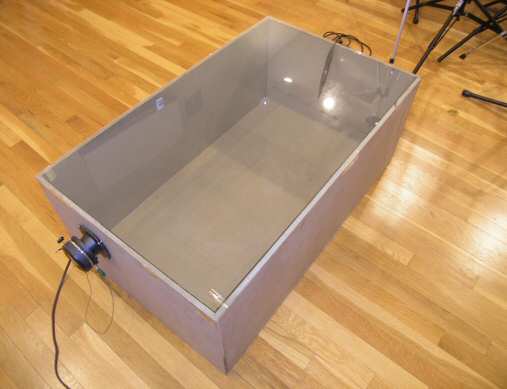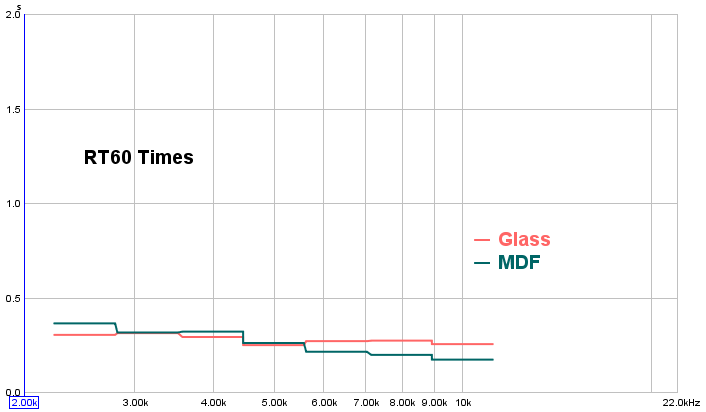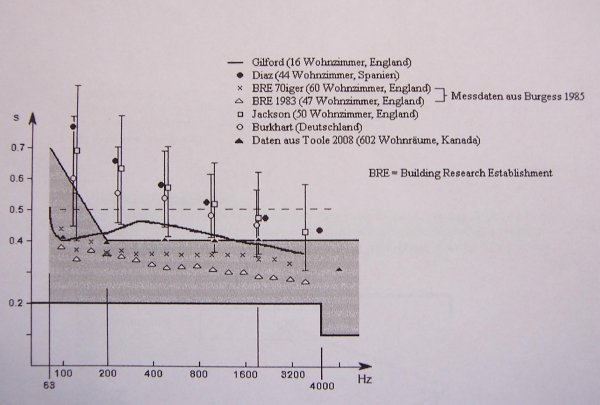Too much travelling has gotten in the way of dealing with this last argument which is almost always quoted verbatim from Davis’ text:
GIK Acoustics said:
In case it all needs to be laid out, Local pointed out (and I agreed) that RT60 is an invalid calculation in small rooms because RT60 is the measurement of the decay time of "a well-mixed reverberant sound field well beyond critical distance".
There are two parts to this: “well-mixed reverberant sound field” and “well beyond critical distance.” Let’s deal with the latter first.
Critical Distance
Critical distance is the distance from the source at which point the level of the direct sound matches the sum total of reflections. The direct sound is what comes to you directly from the speaker. The reflections are caused by the indirect sound bouncing off all the surfaces. Since reflections on the average have longer paths before they get to us, then their level drops more than the direct sound. At the same time, if we keep moving away from our direct sound, that too drops. At some point the sound pressure level from both of these become equal. That is the critical distance denoted by “Dc” not be confused with direct current which we write as DC.
Well Mixed Reverberant Sound Field
There was an assumption in the above explanation: the level of reflections stayed the same even though we kept moving away from our source. For that to be true, the reflections need to be all around us and not location specific. If that is the case, then we can never get farther from them and hence their level will remain constant. That is what Davis means by “well mixed reverberant field.” Another name for it is diffused field. Another is randomness of reflections, modes, etc. All concepts that I have explained before.
Computing Critical Distance
There are a number of formulas for computing Critical Distance. For now, let’s go with one of its simpler form: 0.03121*SQRT(Q*V/RT60). V is the familiar volume of the space. RT60 you already know and is the reverberation of time of the room. Q is the measure of directivity of the source. If the source is omnidirectional, Q=1 and can be eliminated leading to the more simplified version of this formula without it. Higher values connote a more directional source. For example the human voice has directivity of about 2 as your face somewhat projects the energy away from your face.
Our interest here is speakers which have frequency dependent directivity. While designs vary, in general speakers get directional at high frequencies. Conversely at low frequencies they tend to have broader radiation pattern. Determining the actual directivity of a speaker can be difficult if the manufacturer does not provide it. That said, our interest her as with RT60 is the mid frequencies starting at 500 Hz. At 500 Hz, speakers tend to have pretty wide dispersion. I am going to pick a rough (effective) estimate of 150 degrees horizontal and 100 degrees vertical. That gives us a directivity of 3.7. So while higher than a human voice, it is not hugely different. This is why a human can replace the role of a speaker in some ad-hoc room testing.
For my 21x11x9 dedicated theater, using a Q of 3.7 gets us a critical distance of 3.2 feet. For a human talker with a Q of 2, the distance is a short 2.4 feet. I don’t recall my exact measurement distance for that room but it was in the order of 10 feet. This puts the measurement mic at 3 times the critical distance for the speaker. This may not be “well past Dc” but sure is in the neighborhood since the direct sound is dropping at 6 dB/doubling of distance resulting in 9 dB total drop below the reflected sound. Its contribution to total sound arriving at our ear/mic is pretty low then. If that were not low enough, we have plenty more distance to step back into since our room length is 21 feet (~7X critical distance). That said, this computation may not be correct. See the next section.
Plugging in Ethan’s garage and using a Q of 2 because he was making some of those noises with his mouth, and an estimated RT time of 2 seconds, his critical distance is just 1.9 feet. With a room length of 24 feet, he could go way, way past the critical source if he wanted. So the notion that we have to be “well past Dc” in a classic sense is satisfied here.
Limitations of Critical Distance Computation
So far, we have lived in an idealized space. Real spaces,
large or small, don’t work that way. As with the Sabine RT60 equation, as soon as you add any absorption to the room, you lose your diffusivity. Sound hitting those surfaces does not reflect back and even if it did, it would not do so in a flat way with frequency. Put audience in a large concert hall for example and all of a sudden the entire floor area acts like a giant absorber so even though that room is “large” it may have lost its diffusivity/randomness just the same. So technically speaking, rooms big or small if they have absorption in them, they are bound to show error in their Critical Distance computation as well as their RT60. Question then becomes how big this error is in practice.
How about Expert Quotes?
Both Dr. Toole and Davis were quoted as saying we do have a “small room” problem when it comes to these measures. Conclusion was therefore reached that we could never apply these measures to any “small” rooms, including such spaces as Ethan’s garage. Let’s review what they really said so that can see if that was right.
Don Davis’ Sound System Engineering
We were told to read chapter 7 of this book. If we do, we see this explanation:
Our work with the TEF analysis process has confirmed that the simple equations that work so well in “live” rooms should simply not be applied in any form in small dead rooms….In very absorptive rooms, the sound dies away in a few reflections, and the statistical basis of the formulas is weakened. In recent studies done with time energy frequency analysis, typical meeting rooms in hotels have been found in some cases, RT60 = 0.5 s, to develop no reverberant sound field, whereas in others, RT60 = 0.7s, a field barely appears. Our experience with time-energy-frequency measurements causes us to state unequivocally that recording studio control rooms are not proper subjects for use of classic statistical equations.
The emphasis that I have added should already tell you what is wrong with the conclusions drawn. But let’s spell them out:
1. It is absolutely clear that Davis is railing against the simplified formulas, not measurements. I hope you remember the distinction from my
last post. Measurements are immune to many of the errors of simple Sabine equations since they measure the actual sound level at our seating position. For example, lack of diffusivity means that we don’t have the same sound level in every place in the room. But we don’t care about every location. We care about where we sit and the mic picks up the sound level there. That measurement does not rely on us having the same reading elsewhere. Nor does it care about the speaker spec. If we change the Q of the speaker, it will be reflected in what the mic “sees” in our location of interest. That is very different than us plugging the wrong Q into the critical distance formula.
2. There is no better proof of #1 than seeing Davis use RT60 *measurement* himself! And what does he use it for? To determine whether a room is reverberant or not. Well, that is precisely the use we have for RT60. The fact that at 0.5 RT60 time the room loses a lot of its diffusivity/randomness is understood and indeed is the reason we want to add additional absorption: to get rid of excess reverberation/late reflections.
3. Davis acknowledges that reverberant field starts to appear at RT of 0.7. I gave a simple example of my room which with carpet and two rows of seating had similar RT. Clearly then it is possible to have residential spaces that cross the threshold into having a reverberant field. Ethan’s garage likely has RT60 times of ~2 seconds. If 0.7 is onset of the reverberant field, then surely 2.0 seconds is way into it being there.
4. Davis is using “frequency blind” RT60. As I showed in my last post, we can look at specific mid-frequencies and eliminate the low frequencies. In doing so, we actually arrive at more accurate metric then he did because it does not vary as much due to changes in location. This is useful in home theater design where we want to know how every seat measures, rather than just one.
5. Davis reserves the strongest words against use of Sabine formula for “recording studio control rooms.” As a rule, folks in that space, especially in the 1980s when he wrote that book, were strong believers in eliminating first reflections. Popular concept such as Live-end, Dead-end (LEDE) for example attempted to eliminate the reflections from the front of the room. If you substantially reduce the power of the first reflections, the rest do die quickly as he states. So it is not surprising that Davis did not find a reverberant field in such rooms. And how did he confirm that? With measurement:
“our experience with time-energy-frequency measurements…”
Summarizing, it is abundantly clear that Davis is admonishing us from using simplified formulas to characterize small dead spaces. That does not apply to Ethan’s garage that started this argument. His room is anything but dead and he used his ear which is very different than using a formula. Nothing is being said about small rooms automatically invalidating RT60 measurements since he himself uses this measurement.
Dr. Toole
As with Davis’ text, critical parts of Dr. Toole’s writing were left out which shine a proper light on this topic. From his book,
Sound Reproduction:
None of them [sample of rooms examined in the referenced paper] exhibited isotropic distributions at the measurement locations. Strong directional features were associated with early reflections. Small meeting rooms and a videoconferencing room with reverberation times of 0.36–0.4 s, like listening rooms, had anisotropy indices and directional diffusion measures that fell roughly halfway between anechoic and reverberant conditions. Moreover, the values changed with time, with later sound showing increased anisotropy and even changing orientation in the room according to the surfaces that were more reflective (Fig. 5).”
Once again we see that RT60 measurement is not only believed, but actually used to characterize how reverberant the room was – precisely what we use it for. The fact that the room was not isotropic (sound arriving from every location equally as I explained for Critical Distance) did not render RT60 invalid. It would have rendered the formulas less accurate.
Furthermore, as I have explained, it is very true that once you add absorption to get the RT down to recommended level, in this case in the 0.4 range, then your room stops having substantial amount of reverberation/diffused field. But our rooms if they are empty, and Ethan’s garage certainly, don’t start there. Again, my room even with inclusion of carpet and chairs which added substantial amount of absorption due to their large areas still had RT times 0.7 And Ethan's garage much more. These are not not the scenario that Dr. Toole is covering above.
If we wanted to reach into literature, we could find countless references (including some peer reviewed ones) where RT60 is used. Here is an example referenced by Dr. Toole in his book:
“Acoustical Measurements in Some Canadian Homes,” Canadian Acoustics, Bradley, J.S. (1986):
The mean measured receiving room reverberation times and a one standard deviation range are given in Figure 7. In all 1/3 octave bands the mean reverberation time was close to 0.4 seconds with a standard deviation of just under 0.1 seconds.
The above was the mean and deviation of 602 homes surveyed in Canada. Clearly then RT60 is being used to characterize “home” and “small” listening spaces.
BTW times have changed relative to when that study came out. Trend these days is toward a lot more hard surfaces including the key elimination of carpets in favor of hardwood floors. If your room falls in that category, then it is likely to be very “live” with RT60s confirming the same. Here is another personal example in the form of our living room:
RT60 is a whopping 1.7 seconds at mid frequencies. Sadly it sounds that way too. Speech intelligibility is very poor. Get past 6 or 7 feet and it starts to get hard to understand someone over say the background level of TV playing. And forget about understanding them from adjacent room. The room is very bare as this is our vacation house and we have not put much furnishing in it. If we did, we would have this type of experience outlined in Dr. Toole’s book:
Once again we see RT60 measurements being used by the very experts who were portrayed as telling us to not use them. Notice how adding furnishings which act as absorbers, the RT60 time nicely tracked with them. If RT60 generates meaningless data, it should have shown random changes. It did not. More absorption = Smaller RT60 times, precisely what the Sabine formula predicted. Mind you, the changes may not be proportional to exact specs for those “absorbers” but it did track them generally. We don’t need more precision than that.
What does it mean to you
There is little need to measure the critical distance in home listening spaces. There is however usefulness in using RT60 to determine if your room is too live or too dead. You have seen examples of this from the experts quoted and if it is good enough for them, it certainly is good enough for the rest of us

.
Now, if you don’t have measurement tools that is OK. You can do as Ethan did in his garage and use your ears and convenient noise source. Have someone stand where your speakers are and clap their hands. If you hear a long “reverb trail”

, then your room is too live and needs general absorption. That can come in the form of furnishings such as carpets, drapes, etc. or purpose built absorbers. It matters not where you put them since the aim is to reduce general reverberations, not specific early/strong reflections. Note that you don’t want to clap yourself as that would mean the speaker is in the same spot as you which is not how it is in real life.
So as you see, no matter which way we approach the topic, the results are the same: RT60 measurement works and is a useful tool to estimate the amount of late reflections in the room. While the formula version can generate less accurate results (in both small and large rooms), it too can be useful if for example you have not yet built your room and want to estimate how much total absorption you should have. Dr. Toole gives an example of this in his book. Hence the comment:
"In the meantime, the simple Sabine formula provides estimates that are adequate for our purposes in small listening rooms."

















